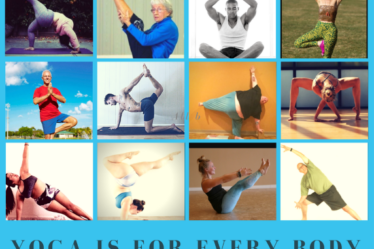
Raise your hand if you love pigeon pose!
Either you love this pose or you hate it. Or you love to hate it. When people request a hip opener in yoga class, this is often the first thing that comes to mind. But did you know that backbends are hip openers? And the splits are hip openers???
In fact, the splits are a “closed” hip, hip opener.
I’m sorry, what? What does that even mean???? I thought the splits were a hamstring stretch!!!
Okay, let’s back up to review from the previous posts (Part 1, Part 2, Part 3 of the Hips Don’t Lie, But Yoga Teachers Do series). If you haven’t already read them, I highly recommend you go back and do that before forging ahead.
Let’s Define HIP OPENERS:
The hip joint has three types of motion available to it:
Flexion and Extension
Abduction and Adduction
Internal and External Rotation
A hip OPENER is any movement of the hip joint (where the femur meets the pelvis) AWAY from the midline: Extension, Abduction, External Rotation. The “hip opener” could include 1, 2, or all 3 of the movements available at the joint.
Pigeon or lizard pose are actually pretty complex hip openers. The front leg finds abduction and external rotation while the back leg finds extension.
The splits however isolate EXTENSION – and in the back leg only. One type of opening movement in only one leg. Backbends (most commonly bridge, camel, or bow pose) offer extension in both legs simultaneously. While I have mentioned in the past that my knees and toes try to to turn out (external rotation) in backbends, my work is to keep everything hugged in and neutral and ONLY find the EXTENSION.
Okay, so we’ve defined hip OPENER and we can see how the splits fall into that category, but what the heck is a closed hip posture and how can one pose be both a hip opener AND a closed hip posture?!?!
OPEN AND CLOSED HIP POSTURES
The terms “open hip” or “closed hip” are generally used as ALIGNMENT cues for the pelvis and the hip joint (specifically internal and external rotation). I think I use this most often in standing poses that most people wouldn’t consider to be “hip openers.” It’s a cue to encourage students to activate different muscles in the legs, glutes, and hips and to rotate the pelvis – or keep it neutral.
Warrior 1 or High Crescent for instance would be examples of “closed hip” postures. What I am referring to in these postures is that there is no external rotation at the hip joint. The pelvis is neutral and both “hip pointers” are facing forward.
The aforementioned backbends would fall into the “closed” hip posture category as would the splits.
Warrior 2 or Extended Side Angle on the other hand would be “open hip” postures. There is external rotation at the hip joint in both legs. A seated butterfly stretch (baddhakonasana) would be another great example.
PHEW, THAT WAS A LOT!
Going back to the original statement about the splits, I hope you can see (and understand) how it that pose is simultaneously a “closed hip posture” AND a “hip opener”!
Your hips don’t lie, but they certainly have a lot to say – and it’s no wonder that yoga teachers (and students) get confused sometimes.
I hope that through this series we have debunked some myths and cleared up any confusing terms you may have heard on your yoga journey.


